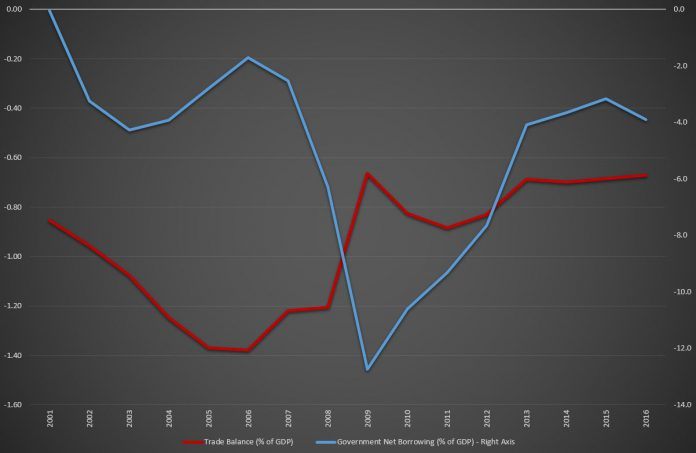Put simply, perhaps the most important reason for the US trade deficit is the US government itself. Allow me to elaborate: bank lending has been growing by about 4% in the past year, while the savings rate and money in circulation have been stable over the past year.
What is left is just government spending. The graph on the top of this post shows evidence of this relationship, supporting the view that a higher deficit (as a percentage of GDP) would be associated with a higher trade balance. The reason is straightforward as higher spending means that more goods and services will be consumed. Many of these goods and services actually have a large percentage of their value imported, a common practice across many companies. In a similar manner, even if the increase in spending goes to social benefits, the argument still remains.
In a simple exercise using data from the Federal Reserve of St. Louis, imports account for about 19% of private consumption, investment, government spending, after adjusting for the import share of exports, suggesting that for a $1 increase in the economy, 19 cents leave the country. If we data just for consumption then this percentage will increase, but let’s keep it on the conservative side.
On the basis of the above, of the $740 billion of government deficit in 2017, approximately $141 billion affect the trade deficit directly, as the government does not really export much. Given that the net trade deficit in 2017 stood at $552 billion, then having just one economic sector accounting for 25% of it is quite much isn’t it? The US should focus more on dealing with the mounting government debt problem than with constraining the economy via trade tariffs.
Disclaimer: Nothing in this communication contains, or should be considered as containing, an investment advice or an investment recommendation or a solicitation for the purpose of purchase or sale of any financial instrument.
Recommended Content
Editors’ Picks
EUR/USD hovers around 1.0700 ahead of German IFO survey

EUR/USD is consolidating recovery gains at around 1.0700 in the European morning on Wednesday. The pair stays afloat amid strong Eurozone business activity data against cooling US manufacturing and services sectors. Germany's IFO survey is next in focus.
USD/JPY refreshes 34-year high, attacks 155.00 as intervention risks loom

USD/JPY is renewing a multi-decade high, closing in on 155.00. Traders turn cautious on heightened risks of Japan's FX intervention. Broad US Dollar rebound aids the upside in the major. US Durable Goods data are next on tap.
Gold: Defending $2,318 support is critical for XAU/USD

Gold price is nursing losses while holding above $2,300 early Wednesday, stalling its two-day decline, as traders look forward to the mid-tier US economic data for fresh cues on the US Federal Reserve interest rates outlook.
Worldcoin looks set for comeback despite Nvidia’s 22% crash Premium

Worldcoin (WLD) price is in a better position than last week's and shows signs of a potential comeback. This development occurs amid the sharp decline in the valuation of the popular GPU manufacturer Nvidia.
Three fundamentals for the week: US GDP, BoJ and the Fed's favorite inflation gauge stand out Premium

While it is hard to predict when geopolitical news erupts, the level of tension is lower – allowing for key data to have its say. This week's US figures are set to shape the Federal Reserve's decision next week – and the Bank of Japan may struggle to halt the Yen's deterioration.
